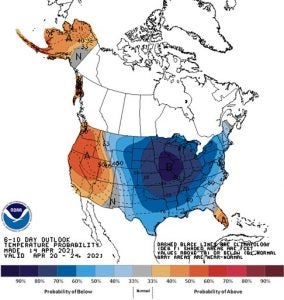This spring’s warmer than normal temperatures and good soil conditions have encouraged producers to plant more soybeans in late March and early April than in previous years. In most years, the cool soil temperatures that typically occur in April, delay soybean emergence, providing some protection from late spring frost/freeze events and low-temperature damage. This is not the case in 2021, according to the Michigan State University Extension.
As of April 15, soybeans are emerging in several early planted fields, exposing the plants to frost/freeze damage. The good news is that the cooler air temperatures predicted to prevail over the next week in much of the Midwest should delay additional seedling emergence and development (figure below). Due to the greater potential for frost/freeze damage, producers that planted in late March or early April should understand how to assess fields for frost/freeze damage and distinguish plants that are viable from those that are not.
During the cotyledon stage, temperatures must fall below 30 degrees Fahrenheit for several hours before soybean plants are damaged. Once the seedlings emerge, fields having more residue on the soil surface are typically at greater risk of injury. This is because crop residue reflects sunlight during the day reducing soil warming and also reduces the radiational warming effect the soil provides at night. However, crop residue can protect emerged seedlings from low temperature injury if the plants are covered by the residue.
Under normal conditions, waiting five days to a week is recommended to assess low temperature damage. However, if cool conditions prevail after the event, extending this window by three to five days is warranted. If the cotyledons or hypocotyl have been severely damaged as in Photo 1, the plant is clearly dead. However, if the cotyledons and hypocotyl appear undamaged, look for signs of new growth. The new growth, if any, will occur at the main growing point or the axillary buds located at the base of the cotyledons. The plant in Photo 2 is alive and viable as evidenced by the new growth emerging from both the main growing point and the axillary buds. The plant in Photo 3 is also viable even though the main growing point appears to be dead, the axillary buds are producing new growth.

If no new growth is seen after 10 to 12 days, the plants are most likely not viable and should be considered dead. Use this information to assess the stand of viable plants in the field and remember that thin soybean stands can produce surprisingly high yields before making any management decisions.


